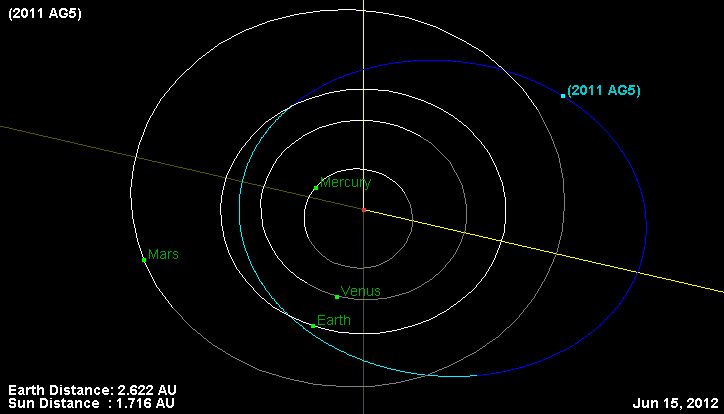Earth Safe From Big Asteroid 2011 AG5 in 2040, Scientists Say

A large asteroid that scientists initially thought could pose a threat to Earth in the year 2040 will actually whiz safely by our planet and leave our world unscathed, NASA astronomers say.
The new prediction is based on new research of the asteroid 2011 AG5, which was discovered in January 2011. The space rock measures approximately 460 feet (140 meters) wide, and was spotted during the Catalina Sky Survey, which is operated by the University of Arizona in Tucson.
Several observatories monitored 2011 AG5 for nine months before it was too far and faint to be detected, NASA officials said.
What was known about 2011 AG5's orbital path, however, showed there was a small possibility that the space rock could collide with Earth in 28 years. But, at a recent workshop at NASA's Goddard Space Flight Center in Greenbelt, Md., scientists presented new findings, and said they are confident that in the next four years, ground- and space-based observations will indicate that the chance of 2011 AG5 missing Earth will be greater than 99 percent. [7 Strangest Asteroids in the Solar System]
"While there is general consensus there is only a very small chance that we could be dealing with a real impact scenario for this object, we will still be watchful and ready to take further action if additional observations indicate it is warranted," Lindley Johnson, program executive for the Near-Earth Object (NEO) Observation Program at NASA Headquarters in Washington, D.C., said in a statement today (June 15).
At the workshop held at Goddard on May 29, scientists and engineers from around the world shared observations about potentially hazardous asteroids, in hopes of mitigating the asteroid threat to Earth.
Hard-to-spot asteroid
Sign up for the Live Science daily newsletter now
Get the world’s most fascinating discoveries delivered straight to your inbox.
Astronomers have struggled to observe 2011 AG5 because at the moment it is beyond the orbit of Mars and in the daytime sky, on the other side of the sun.
Telescopes in space and on the ground are expected to get a better view of the asteroid in the fall of 2013, when 2011 AG5 will be 91 million miles (147 million kilometers) from Earth, but in a much better location for observations in the late evening sky. This will allow researchers to gather much more information about the asteroid's path, NASA officials said.
"Any time we're able to observe an asteroid and obtain new location data, we're able to refine our calculations of the asteroid's future path," Don Yeomans, manager of NASA's NEO Program Office at the Jet Propulsion Laboratory in Pasadena, Calif., said in a statement. "When few observations exist, our initial orbit calculation will include a wider swath to account for uncertainties. With more data points, the knowledge of the potential positions of the asteroid improves and the swath becomes smaller — typically eliminating the risk of an impact."
When the asteroid is approximately 1.1 million miles (1.8 million km) away from Earth in 2023, astronomers will have an even clearer picture of the degree of hazard posed by 2011 AG5.
In February 2023, if the asteroid passes through a 227-mile-wide (365-km) are in space that astronomers call a "keyhole," Earth's gravitational pull could tug on the rock's orbital path just enough to bring it back for an impact on Feb. 5, 2040, NASA scientists said. But, if the asteroid avoids the keyhole, a collision in 2040 will not occur. [Photos: Asteroids in Deep Space]
"Given our current understanding of this asteroid's orbit, there is only a very remote chance of this keyhole passage even occurring," Johnson said.
Asteroid tracking planned
Still, while there are indications that 2011 AG5 will fly safely past Earth, NASA researchers say they will continue to monitor the space rock, in case the likelihood of impact rises as a result of observations that will be taken from 2013 to 2016.
Yet, attendees at the workshop discussed this scenario and said that even if the odds do increase, there is plenty of time to plan and carry out at least one of several viable missions to deflect or alter the asteroid's course.
Several years ago, a different asteroid, known as Apophis, was thought to pose a similar threat of colliding with Earth in the year 2036. NASA scientists carefully examined the path of the space rock using observations taken from 2005 to 2008. Through this work, the researchers were able to see a significantly reduced chance of a hazardous impact.
Potentially hazardous asteroids are a type of near-Earth asteroids that have the closest orbits to the planet, coming within 5 million miles (roughly 8 million km). These objects are large enough to pass through Earth's atmosphere intact, which could result in damage on at least a local scale, NASA officials have said.
If an asteroid the size of 2011 AG5 hit Earth, it would cause damage to a region stretching at least 100 miles (161 km) wide, the researchers said.
NASA's NEO Program was established in 1998 to coordinate the agency's efforts to detect, track and characterize Earth-approaching NEOs and comets larger than 0.62 miles (1 km) in size. The program now also searches for NEOs as small as asteroid 2011 AG5, agency officials said.
This story was provided by SPACE.com, a sister site to LiveScience. Follow SPACE.com on Twitter @Spacedotcom. We're also on Facebook & Google+.













